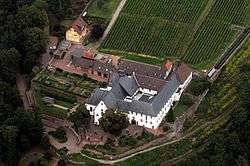Engelberg Abbey (Bavaria)
|
Aerial view from 2008 | |
 Location within Germany | |
| Monastery information | |
|---|---|
| Order | Franciscan |
| Established | 1630s |
| Dedicated to | B.V. Mariae gloriosae |
| Diocese | Würzburg |
| People | |
| Founder(s) | Cologne Observantenprovinz of the Franciscans |
| Architecture | |
| Heritage designation | listed monument |
| Style | mostly Baroque |
| Site | |
| Location | Grossheubach, Bavaria, Germany |
| Coordinates | 49°43′26″N 9°13′55″E / 49.72389°N 9.23194°E |
| Public access | yes (limited) |
Kloster Engelberg (Engelberg Abbey) is a Franciscan monastery in Grossheubach in Bavaria, Germany.
Location
Kloster Engelberg is located on the hill Engelberg ("hill of Angels") above the town of Grossheubach, on the right bank of the river Main near the district town of Miltenberg.
It is passed by the long-distance hiking trail Eselsweg which connects Schlüchtern to Grossheubach and follows the route of a historic road that was used to transport salt across the Spessart range.
History


The hill spur on which the abbey is situated was likely used in prehistoric times as a cult site. Around 1300, a chapel dedicated to St. Michael was built there and a statue of Mary erected. The likely location of this chapel was where the choir of today's church stands. The first documented pilgrimage occurred in 1406. In 1469, a brotherhood was established in connection with the Engelberg pilgrimage.[1]
In 1630, Anselm Kasimir von Wambold, Archbishop of Mainz, asked Capuchins from the Rhenish Province to come here. The abbey was finished by 1639. At the same time the church was enlarged and largely achieved its current, Baroque, form. After 1647, the monastery had the status of Konvent (previously it had been a pilgrims' Hospice). In 1697, the Antonius chapel was added. In 1701, a Gnadenbild der Freudenreichen Muttergottes from the mid-14th century, was erected in the right side-chapel.[1]
When the German ecclesial states were securalized in the early 19th century in what is known as the German mediatization, Engelberg was initially not much affected. The acceptance of novices was forbidden, though, setting it up for eventual extinction. In 1817, the Gymnasium (school) was dissolved. However, in 1828, King Ludwig I of Bavaria ordered the monks to move to Aschaffenburg. The monastery was refounded, but Franciscans of the Bavarian Order Province took over in taking care of pilgrims.[1]
A burial chapel for the Catholic branch of House Löwenstein was built next to the church. In 1899, the church was enlarged towards the west. A terrace was added as well as the room which today serves as a confessional chapel.[1]
The pilgrimage continues. Well into the post-WWII period, some pilgrims climbed the steps to the abbey on their knees while praying.[1]
Description
The pilgrimage way (612 steps of red sandstone, the so-called Engelsstaffeln) through the vineyards from Grossheubach features 14 Baroque chapels and 14 Stations of the Cross from 1866.[1]
The current set of mostly Baroque monastic buildings are quite simple architecturally, reflecting their origins during the Thirty Years' War. Back then, measured by its message, the most important work of art was the larger-than-life statue of St. Michael set above the church portal, created by Zacharias Juncker the Older (from a family of sculptors) around 1635. It references a much more significant statue of the saint created by Hubert Gerhard for the Michaelskirche at Munich. The statue at Engelberg was erected after the Protestant Swedish had been beaten and driven out of Franconia, turning the monastery into a monument to the resurrected power of the Catholic faith.[1]
Today
It remains one of the most important sites of pilgrimages in the Würzburg diocese.[1]
The church and some other areas of the monastery are open to visitors. The order runs a restaurant and shop in the buildings.
References
External links
| Wikimedia Commons has media related to Franziskanerkloster Engelberg. |
- Website (German)
Further reading
- Breuer, Tilmann (et al., ed.): Georg Dehio, Franken, Handbuch der Deutschen Kunstdenkmäler, Bayern I, München/Berlin 1999, p. 406
- Karfreitag, P. Willibald: Geschichte und Beschreibung von Engelberg, Bamberg 1926
- Mader, Felix/Karlinger, Hans: Bezirksamt Miltenberg, KDB III/XVIII, München 1917, p. 128-135
- Madler, Philipp J.: Das Kloster auf dem Engelberg; geschichtlich, topographisch beschriebe, Amorbach, 1843 (Online version)
- Madler, Philipp J.: Das Kloster auf dem Engelberg und die Familiengruft des Fürstenhauses Löwenstein-Wertheim-Rosenberg, Weiden, 1857 (Online version)
- Nutz, Johannes: Großheubach, Engelberg. In: Brückner, Wolfgang/Schneider, Wolfgang (ed.), Wallfahrt im Bistum Würzburg. Gnadenorte, Kult- und Andachtsstätten in Unterfranken, Würzburg 1996, p. 129-132
- Schneider, Erich: Klöster und Stifte in Mainfranken, Würzburg 1993, p. 24
- Spatz, Thomas: Wallfahrtskirche Engelberg ob dem Main, München 1989
- Vad, Nobert: Franziskanerkloster und Wallfahrtskirche Engelberg ob dem Main, Schnell und Steiner, 2006, ISBN 3-7954-6601-6
